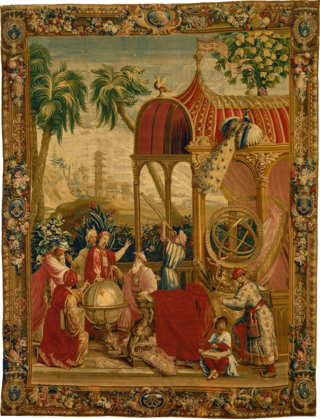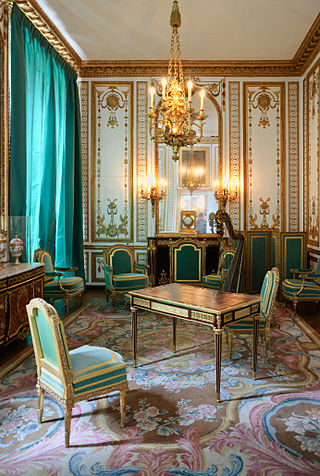
Aubusson is a commune in the Creuse department region in central France.

Tapestry is a form of textile art, traditionally woven by hand on a loom. Normally it is used to create images rather than patterns. Tapestry is relatively fragile, and difficult to make, so most historical pieces are intended to hang vertically on a wall, or sometimes horizontally over a piece of furniture such as a table or bed. Some periods made smaller pieces, often long and narrow and used as borders for other textiles. Most weavers use a natural warp thread, such as wool, linen, or cotton. The weft threads are usually wool or cotton but may include silk, gold, silver, or other alternatives.

The Gobelins Manufactory is a historic tapestry factory in Paris, France. It is located at 42 avenue des Gobelins, near Les Gobelins métro station in the 13th arrondissement of Paris. It was originally established on the site as a medieval dyeing business by the family Gobelin.

Jean Lurçat was a French artist noted for his role in the revival of contemporary tapestry.

Mauriac is a commune in the Cantal department in the Auvergne region in south-central France.

Jean-Baptiste Marie Huet was a French painter, engraver and designer associated with pastoral and genre scenes of animals in the Rococo manner, influenced by François Boucher.

The Savonnerie manufactory was the most prestigious European manufactory of knotted-pile carpets, enjoying its greatest period c. 1650–1685; the cachet of its name is casually applied to many knotted-pile carpets made at other centers. The manufactory had its immediate origins in a carpet manufactory established in a former soap factory on the Quai de Chaillot downstream of Paris in 1615 by Pierre DuPont, who was returning from the Levant.

The Beauvais Manufactory is a historic tapestry factory in Beauvais, France. It was the second in importance, after the Gobelins Manufactory, of French tapestry workshops that were established under the general direction of Jean-Baptiste Colbert, the finance minister of Louis XIV. Whereas the royal Gobelins Manufactory executed tapestries for the royal residences and as ambassadorial gifts, the manufacture at Beauvais remained a private enterprise. Beauvais specialised in low-warp tapestry weaving, although the letters patent of 1664, authorising the company and offering royal protection, left the field open for the production of high-warp tapestry as well.

Felletin is a commune in the Creuse department in the Nouvelle-Aquitaine region in central France.
Bellegarde-en-Marche is a commune in the Creuse department in the Nouvelle-Aquitaine region in central France.

Louis XVI style, also called Louis Seize, is a style of architecture, furniture, decoration and art which developed in France during the 19-year reign of Louis XVI (1774–1793), just before the French Revolution. It saw the final phase of the Baroque style as well as the birth of French Neoclassicism. The style was a reaction against the elaborate ornament of the preceding Baroque period. It was inspired in part by the discoveries of Ancient Roman paintings, sculpture and architecture in Herculaneum and Pompeii. Its features included the straight column, the simplicity of the post-and-lintel, the architrave of the Greek temple. It also expressed the Rousseau-inspired values of returning to nature and the view of nature as an idealized and wild but still orderly and inherently worthy model for the arts to follow.

The Pastoral Amusements, is a series of tapestries designed between 1720 and 1730 by Jean-Baptiste Oudry for Noël-Antoine de Mérou, then director of the Royal Beauvais Tapestry Manufactory. The first production of the designs took place at Beauvais in 1731. After enjoying huge success the series was later adapted and further developed at Aubusson by Jean-Baptiste Huet the elder.
Jane Kahan Gallery is an art gallery located in New York City that specializes in modern art. The gallery collection is founded on prints, monotypes, and paintings, including ceramics and works on paper by Pablo Picasso, and tapestries by artists such as Romare Bearden, Alexander Calder, Marc Chagall, Sonia Delaunay, Roberto Sebastián Matta, and Fernand Léger. Established by art dealer and collector Jane Kahan in 1973 following graduation from Mount Holyoke College, the gallery initially operated as Kahan Esikoff Fine Arts prior to changing the name to Jane Kahan Gallery. The gallery maintains its original space on the Upper East Side and an exhibition space in Lower Manhattan.

Brussels tapestry workshops produced tapestry from at least the 15th century, but the city's early production in the Late Gothic International style was eclipsed by the more prominent tapestry-weaving workshops based in Arras and Tournai. In 1477 Brussels, capital of the duchy of Brabant, was inherited by the house of Habsburg; and in the same year Arras, the prominent center of tapestry-weaving in the Low Countries, was sacked and its tapestry manufacture never recovered, and Tournai and Brussels seem to have increased in importance.

The American Tapestry Alliance (ATA) is an association of a broad range of tapestry enthusiasts. ATA was founded in the United States in 1982. It provides educational programs, exhibition opportunities, and a variety of awards for tapestry artists. In addition, ATA publishes a quarterly journal, Tapestry Topics.
A textile museum is a museum with exhibits relating to the history and art of textiles, including:

The Franses Tapestry Archive and Library in London is devoted to the study of European tapestries and figurative textiles. It is the world’s largest academic research resource on the subject.

The Leyniers family (/lɛnɪjɛ/) is a bourgeois family that appeared in Brussels in the 15th century and produced many high-level tapestry makers and dyers, experts in the art of dyeing in subtle shades the woolen threads destined for this trade.

The Don Quixote tapestry series is a popular series of 18th century mural-scale tapestries illustrating scenes from the Miguel de Cervantes novel, Don Quixote. The series was woven at the Gobelins Manufactory in Paris from 1714 to 1794, during which they were the most frequently reproduced series in the manufactory with over 200 panels woven. Their design marked the emergence of elaborate alentour borders in tapestries.

Braquenié et Cie was a French fabric designer and manufacturer. The company was founded in 1823.























